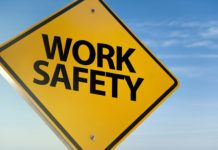There are lots of reasons for OSHA to come knocking at your door, but none are particularly pleasant. The financially and manpower-strapped agency typically arranges its visits based upon a higher-than-normal incident rate, accident and/or death, complaint, or perceived imminent danger.
Whatever the case, it’s important for a company to be prepared. This is especially true for the small to mid-sized company that might not necessarily have dedicated personnel to handle a safety program and its associated documentation.
OSHA’s purpose is not merely to punish wrongdoers—though sometimes necessary—but also to promote safer worksites. As such, they provide resources on their website that enable an employer to stay abreast of the latest in regulations as well as prepare for an inspection. Additionally, OSHA’s On-Site Consultation Program offers free and confidential advice to small and medium-sized businesses in every state, with priority given to high-hazard worksites. On-site consultation services are separate from enforcement and do not result in penalties or citations.
The agency also collaborates with local industry groups. In May, OSHA formed an alliance with the Greater Baton Rouge Industry Alliance and the Louisiana Chemical Association to provide their members with information, guidance and access to training resources.
Wayne Smith, regional safety manager for a major petrochemical plant in Lake Charles, says his safety personnel attend regional and national Voluntary Protection Program workshops to keep up to date on the latest regulations. “It gives you a good insight into what’s going on. And OSHA also puts out a lot of publications about what they’re finding and their top 10 violations for the previous year.”
Still, staying on top of the latest iterations of OSHA policy, along with the voluminous amount of documentation, can be a daunting task. Fortunately, Smith and other safety professionals say, there are some steps an employer of any size can take to ensure an inspection goes smoothly, regardless of the circumstances.
Above all else, get your documentation in order.

It sounds simple—but always be prepared. If you’ve got your house in order, can answer questions and provide documentation, inspections will go more smoothly and have a better outcome. Ironically, those plants that have historically low incident rates and are “flying under the radar” are less likely to have their paperwork organized. “It probably has less to do with size and more to do with the frequency of that interaction [with OSHA],” Smith says.
Rightly or wrongly, if you give the impression that you’re unorganized, it’s fertile ground for the inspection to go deeper. “You always need to be ready for an inspection,” he adds. “All of your training records, injury logs and incident investigations—all that stuff needs to be organized and readily retrievable.”
Employers should have a current copy of the OSHA standards that are applicable to them, as well as any other standards such as ANSI (American National Standards Institute). “That’s because no one can remember all of that,” Smith says. “I’ve been doing this for 29 years and sometimes I still have to grab the book.”
Adam Beary, president and CEO of safety management solutions firm Bear Process Safety in Baton Rouge, says people get “dinged” most often for poorly maintained documentation. Bear Process Safety is the newest tenant at the Louisiana Business and Technology Center at LSU Innovation Park in Baton Rouge, and among other things provides auditing services to determine if companies are in line with OSHA standards.
“If you’re preparing for an inspection and want to make your program top-notch, develop a consistent documentation protocol,” Beary adds. “Be consistent across the site, and depending upon your corporate structure, be consistent companywide.”
He encourages the use of an outside consultant if an owner is unable to dedicate adequate internal resources to managing its documentation. Technology is also helping in some respects. “There are a couple of companies developing technology in terms of databases, and how to interconnect all those databases together. Those that have made the best strides have been those using available software.”
One note of caution—in recent years there have been conflicting applicability interpretations over OSHA standards. Beary suggests having documentation that thoroughly explains which OSHA standards are applicable to a site and which are not. “You don’t want a situation where an inspector says, ‘I think this is applicable’ but you don’t have documentation to prove it’s not. In that case, you would have no safety documentation for that particular section of the plant.”
Develop a comprehensive inspection procedure.
No matter the size of the organization, a company and/or plant should develop and fine tune its audit procedures and train all applicable personnel on the process.
“When OSHA shows up, everyone should know who is going to meet with them and be the point of contact during that visit,” Smith says. “At each plant there should be someone designated to handle an inspection, or lead and assist inspectors. It should be someone knowledgeable.
“Those folks need some specific training and know-how to associate with the inspectors.” While they should be honest, cordial and forthcoming, they also need to know how to protect the company’s rights.
Perform your own internal audit.

Regular internal auditing of a company’s safety program can be a critical first line of defense. Through the American Chemistry Council’s Responsible Care program, Beary assists companies with performing internal audits to weed out problem areas. Participating companies are committed to open and transparent reporting and undergo mandatory headquarters and facility audits to certify their performance.
“It’s an internal auditing system that prepares them for any type of inspection,” Beary says. “Responsible Care is above and beyond OSHA because it incorporates your internal standards and documents as well. It’s kind of a mock audit, to be able to come in and say, ‘Here’s where we notice your deficiencies. This is what we can see could be a real issue.’”
An environmental, health, safety and security performance initiative, Responsible Care has helped member companies enhance their performance and improve the health and safety of their employees, the communities in which they operate and the environment as a whole.
What to do on OSHA inspection day.
With an annual federal budget of less than $900 million a year and fewer than 3,000 employees nationwide, OSHA is responsible for approximately 7 million work sites. And in Louisiana, OSHA’s Baton Rouge office is responsible for the entire state. This can make the timing of an inspection unpredictable.
If adequate workforce is available, OSHA will match a compliance officer to a particular industry, then typically send a single inspector to perform the entirety of the process.
The length of an audit can also vary significantly. “I’ve had OSHA inspections that lasted just two hours,” says Rightor Cobb, owner of PBM Training Services and an independent contractor for the Alliance Safety Council in Baton Rouge. “Then, I’ve had some that lasted a week. It took them that long to gather information, or to perform additional testing on fumes or vapor, check chemicals, measure noise, etc. In extreme cases, we’ve had OSHA visits that lasted over two years.”
Once at the site, the OSHA compliance safety and health officer (CSHO) has a protocol to follow, writes Dan Johnson, managing partner of SFI Compliance Inc. in Denver, in a recent issue of EHS Today. “This includes checking in and obtaining permission to conduct the inspection. Make sure your receptionist knows whom to contact when OSHA arrives. It is best to get a supervisor or manager present as soon as possible to greet the CSHO.”
After verifying the CSHO’s credentials, determine why the CSHO wants to inspect your workplace. “Tell the CSHO that it is your company policy to contact your management prior to starting the inspection,” Johnson writes. “At this point, you have not given the CSHO permission to inspect your workplace, so he or she should wait until the proper managers arrive.”

From there, the inspector follows a three-step process:
• Opening Conference: This is a forum for discussing the reasons for the inspection, scope, rights and responsibilities. As such, be sure to take detailed notes of everything discussed. “Depending upon the type of inspection, they’re normally going to request written documents at this time, such as training records, procedures, etc.” Cobb says. Through it all, the owner’s representative should act in a professional, businesslike manner.
“If more than one CSHO is going to inspect, find out if they plan to make the inspection in one group or split into two or more groups,” Johnson writes in EHS Today. “If they want to divide into two or more groups, tell the CSHO you require an employer representative with each group.” Also, inform the CSHO that you will be taking notes of all the suspected violations so that there will be no dispute.
• Walk-around: Next, the inspector will enter the work site for a “walk-around.” Throughout the process, they should have an employer escort.
If the inspection follows an accident or fatality, Cobb says, they’ll want to go to the scene of the incident. Regardless of the reason for the visit, they’re going to compare written documents from the opening conference with what they see and hear. If there is a procedure described in the opening conference, they will want to see how that procedure is being implemented in the field.
“One of the biggest tools in their bag (during the walk-around) is the employee interview,” Cobb says. “Those are private interviews between the employee and the compliance officer. The employer is not allowed to interfere in any way.”
During this part of the inspection, the CSHO will gather evidence for a citation, if necessary. “If the CSHO asks questions about issues related to work that is being performed by a subcontractor, refer those questions to the subcontractor’s competent person,” Johnson writes. “Take detailed notes of everything seen, discussed and done by the CSHO, and take photographs of everything the CSHO photographs.”
Along the way, honesty is imperative. “It could be a very casual conversation, but if you tell them something intending to mislead them, then that can become an additional problem,” Cobb says. Furthermore, if you do not understand everything the inspector says, ask questions. Insist on having time to record all facts, even if it slows down the inspection.
• Closing Conference: At this stage, the inspector will return to the designated office location to explain any concerns to the owner’s representative, typically on the same day as the inspection.
During this process, it is important to take notes of everything discussed, record what documents were distributed and make sure all questions are answered. It is important that you not give the inspector any estimate of abatement time during the closing conference.
Back at the OSHA office, the inspector will review the details of the case with their supervisor to ensure the citations are based on facts. The citation(s) will arrive at your office by mail no more than six months following the inspection.









